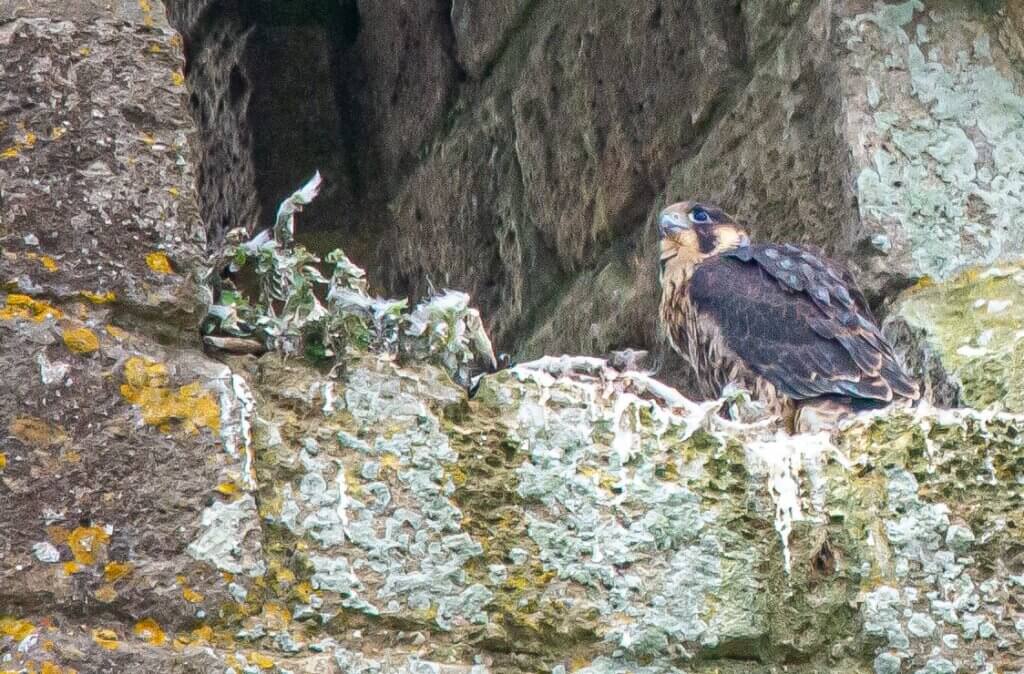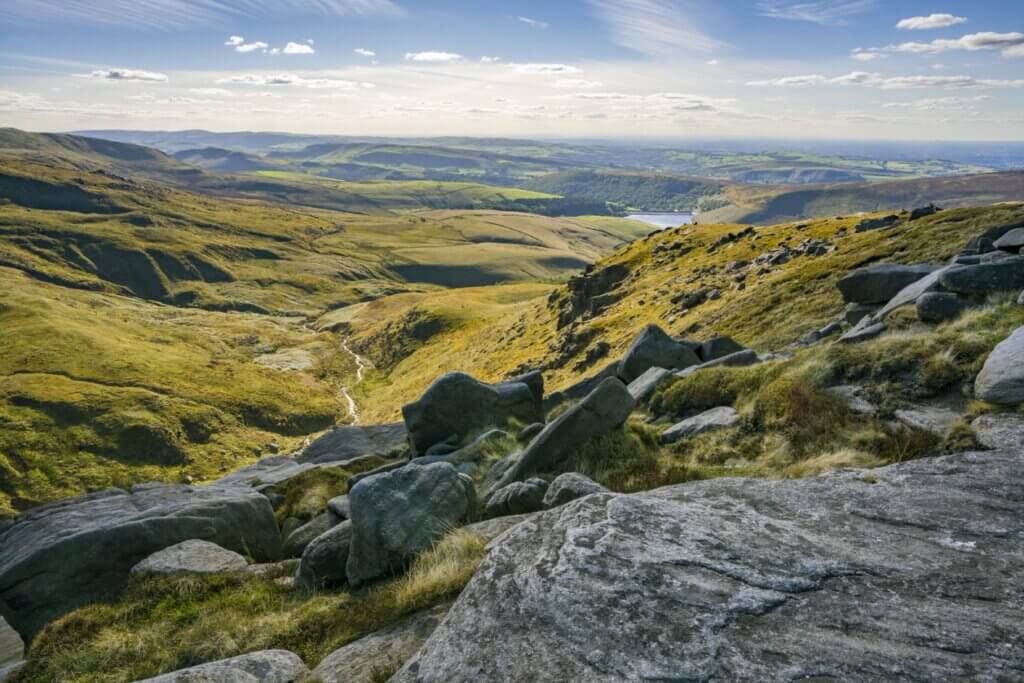National Trust sites prove successful breeding grounds for peregrine falcons
- 11 peregrine falcon chicks discovered at four sites cared for by the National Trust
- Lockdown pair at Corfe Castle successfully hatch three chicks, and the return of visitors hasn’t put them off
- Peaks partnership work results in most successful breeding season in High Peak since conservation project began

Eleven rare peregrine falcon chicks have successfully hatched and are soon to fledge at four sites cared for by the National Trust.
A pair of peregrines, which first found fame at the start of lockdown when they built a nest 70 feet (21 metres) up on the Keep walls of the 12th Century Corfe Castle, have successfully reared three chicks; and eight chicks have been discovered over the past few weeks at three sites cared for by the conservation charity in the High Peak Moors area of the Peak District. A ninth chick is also about to fledge on a site adjacent to National Trust land.

It is the first time the raptors have nested in the ruins of Corfe Castle since the 1980s, and the discoveries of the breeding pairs in the Peak District mark a doubling in numbers of this special bird since recording began in 2012.
Peregrines are the largest of the wild falcons that breed in the UK, with the average adult wingspan reaching up to 1.2 metres. The UK population of these majestic birds significantly declined up to the 1960 and 70s as a result of human persecution and pesticides. While improved legislation and protection has helped to increase the number of breeding pairs to around 1,769 across the UK, Isle of Man and Channel Islands this is still low, especially in upland areas.
At Corfe, the team suspect the birds moved in because of the absence of visitors due to lockdown. Tom Clarke, Nature Engagement Officer for the National Trust says: “Despite the peregrines having up to 700 visitors walking past each day after we reopened, the youngsters are doing well and are starting to fledge.
The peregrines moving in just as we went into lockdown was perfect timing. It gave them a quiet castle to make a nest and lay their eggs. By the time we opened the eggs had hatched and the parents were very unlikely to abandon their nest.
They’ve wowed our visitors for the past six weeks and are now starting to leave the nest. Visitors are currently able to see the parents luring their offspring into the big wide world by offering prey that they’ve captured.
We’ll never know if the pair of birds would have moved in without lockdown, but we are hoping that this pair will come back next year having discovered an amazing site and learnt to tolerate people being below their nest.”

The latest discovery of two chicks and their parents in the High Peak Moors was made by volunteers from the Peak District Raptor Monitoring Group (PDRMG). This new breeding location takes the total number of successful breeding pairs discovered in the moors of the National Park this year to six, double the average since the Peak District Bird of Prey Initiative began reporting in 2012, and its aim is to work towards encouraging at least 17 breeding pairs.
Working in partnership with the Trust, and licenced by the British Trust for Ornithology and Natural England, the PDRMG volunteers have ringed the birds so they can be monitored in the future.

National Trust Area Ranger in the Peak District, Kait Jones, said: “The discovery of the latest two chicks was really exciting. Identifying a new breeding pair along with two healthy chicks is very promising for their future in this area. While the location is thankfully remote, it is not where we’d expect to find a nest.
We think they may have chosen the site partly because of the lack of disturbance earlier in the year during lockdown when wildlife had the place to themselves. Together with our partners from the local Raptor Monitoring Group and our tenants, we’re doing everything we can to keep them safe.
It’s vital that any visitors who may come across the sites keep their distance at this key time in the chick’s development. If the parents are disturbed, they may not return to feed the youngsters and they will sadly die.”.
Jon Stewart, General Manager for the National Trust in the Peak District, said: “Our vision is for the moors to be a landscape full of wildlife and we’re working with our tenants and partners to help achieve this. This work includes habitat management. The fact that this and other birds of prey are making their home here is a sign that our High Peak Moors Vision of maintaining a healthy, natural environment is paying off for wildlife.
The peregrine is one of the most exciting species of the moors so it is brilliant to have a new breeding pair. If we give them the opportunity to thrive and grow up, these chicks will become the fastest animals in the world. It’s known that stooping adults hunting prey can reach speeds of over 200mph. That is something to wonder at.”.
The National Trust is encouraging all visitors to Corfe Castle and the Peak District to play their part in looking after this special environment which is home to so many species of wildlife.
“Everyone can help to look after wildlife,” continued Kait. “It’s pretty simple really, we ask people to please stick to paths, avoid making fires or using barbecues and keep their dogs on a short lead. As these chicks show, you never know what you’ll find around the corner.”
ENDS
[registration_form]
That’s really good news, just as long as those that like to kill our wildlife for fun don’t shoot them when they are fully fledged as happens so often, especially in the Peak District.
We too have been monitoring a pair of Peregrine Falcons. They have been nesting on the top of a tall BT building in Newbury. They have just recently successfully fledged three chicks.
It seems as though generally it has been quite a good breeding season as lack of disturbance because of lock down, coincided with the long spell of fine weather in April and May, the critical time for breeding birds.
Is that racing pigeon leg ring in the last photo? The chicks have just fledged from the nest on the hill above my house and have been spending a lot of time chasing the parents around screaming. I can sometimes hear them over the noise of my own kids chasing me around screaming.
All credit to PDRMG, for not jumping ship from the Bird of Prey Initiative, even when others thought it beyond rescue.
Engaging, and building working relationships, with tenants and keepers is bearing fruit, other species, notably Goshawk, have also shown encouraging improvement, and i expect this to
progress further over the next few years.
Trapit – I hope that is so. Fingers crossed.
Surely yet again highlights very clearly how many raptor nest failures are caused by over disturbance by both the general public and in some cases overzealous raptor fieldworkers! Remember the scenario a few years back with major hen harrier breeding attempt failures due to red fox predation on Skye http://www.skye-birds.com/blog/2017/08
Mr Groves – thank you for your first comment here. How does it do that exactly?
As a long term raptor worker I’ve heard that old chestnut about ” raptor nest failures are caused by over disturbance by both the general public and in some cases overzealous raptor fieldworkers! ”
Can you provide evidence because it has been stated many times, usually by folk from the “dark side” including Duncan Thomas but frankly there is FA evidence to support this claim. It is a diversionary tactic by the criminals that usually damage the nesting attempts of raptors.
Maybe the Trust might manage a Hen Harrier before too long !?
Had em’ Roderick, just not this year, not in the Peak anyway.